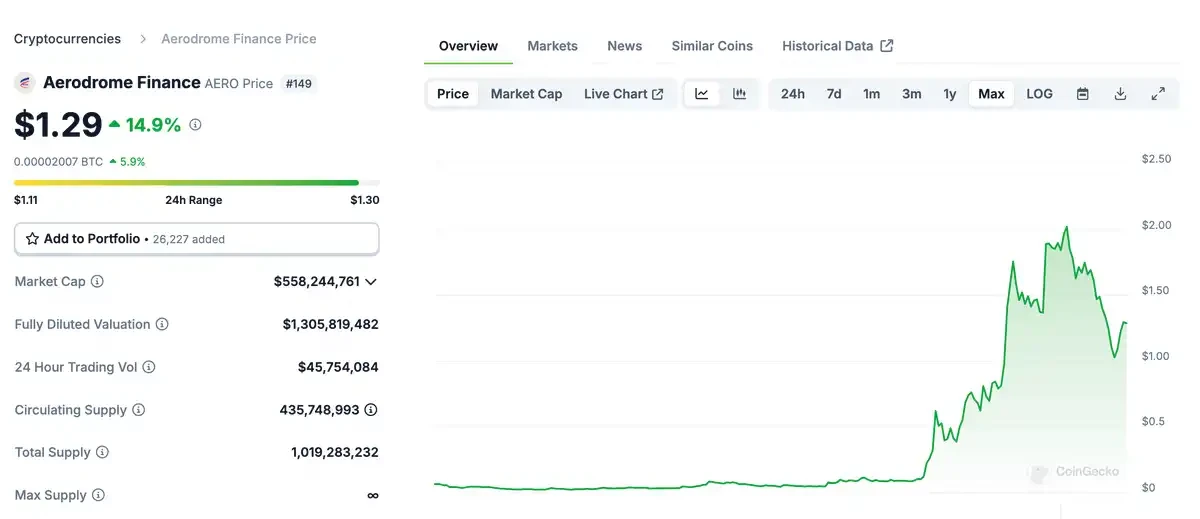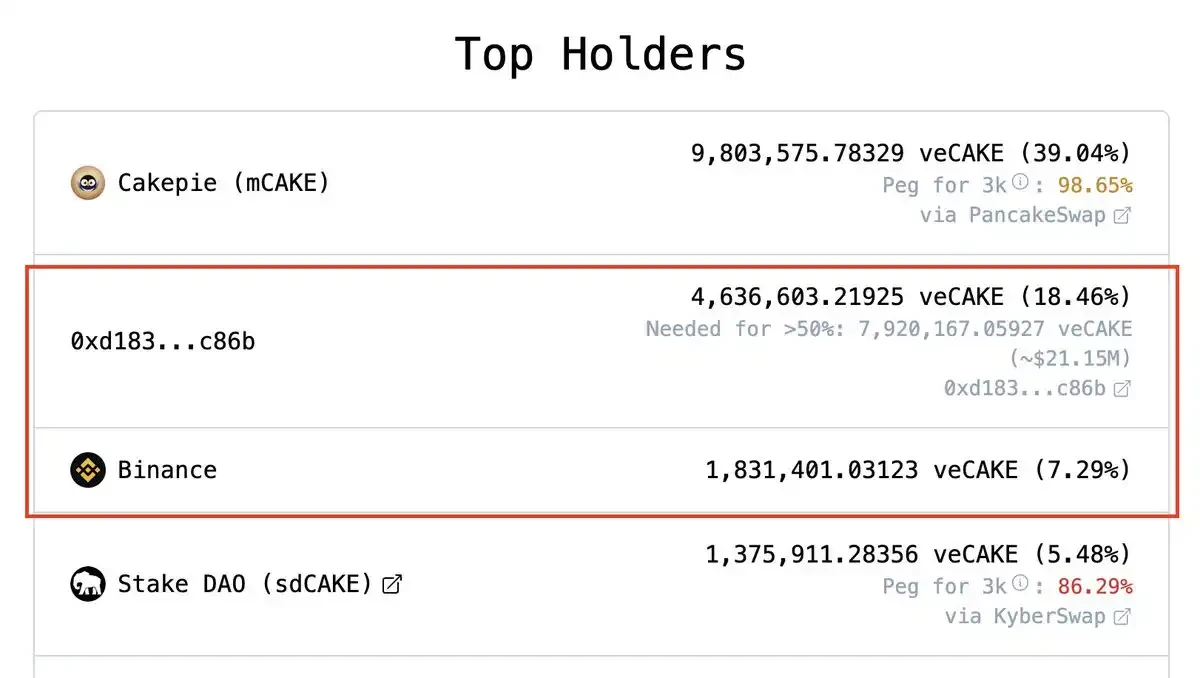출처: CapitalismLab
에어드롬스 가격은 라운드를 거쳤고, Base는 단독으로 피크 1 B Mcap, 2B FDV, 100배 코인을 지원하여 그 근성을 과시했습니다. 그것이 가져온 긍정적인 외부 효과도 Base 생태계를 더욱 활성화했습니다.
반면, BSC는 이번 라운드에서 신발이 떨어진 후에도 아무런 진전이 없었습니다. 격차는 어디에 있을까요? 이 스레드는 이것을 시작점으로 삼아 이번 라운드에서 체인의 두 CEX 사이의 격차를 논의하고 논평할 것입니다.

Coinbase가 Aero를 철회한 이유는 매우 간단합니다. 아래 그림에서 볼 수 있듯이, 과거에는 프로젝트가 DeFi 채굴자에게 직접적인 인센티브를 제공했습니다. 예를 들어, $2의 가치가 있는 프로젝트 토큰의 경우, 채굴자는 DEX 거래 수수료에서 추가로 $1을 얻을 수 있으며, 총 $3이 됩니다.
Aero와 같은 Ve(3, 3) DEX 시스템에서 $3는 veAero에 뇌물을 주는 데 사용되며, veAero는 채굴자들에게 $Aero 토큰(예: $9와 같이 더 높은 가치)을 할당하기로 투표합니다.

결국 프로젝트 소유자는 여전히 $3을 지불했고, veAero(Aero 잠금)는 $3의 실제 이익을 얻었으며 채굴자들은 인센티브가 두 배가 된 $9의 인센티브를 받았습니다.
Aero의 가격이 높을수록 발행되는 인센티브 가치가 높아지고 Base 생태 프로젝트가 누릴 수 있는 인센티브가 높아지며 생태 프로젝트의 기본이 강화됩니다. Aero에 제공할 수 있는 뇌물 토큰의 가치도 높아지고 Aero의 수입도 높아지며 가격은 플라이휠을 형성하는 데 더 낙관적일 것입니다.

또한 Base가 온체인 프로젝트에 직접 인센티브를 제공하면 한편으로는 오프체인 관계 구축이 쉽게 되고, 다른 한편으로는 로컬 도그 및 밈 프로젝트에 공개적으로 인센티브를 제공하기 쉽지 않습니다. 이러한 프로젝트는 트래픽이 있으며 Aero를 지원함으로써 온체인 생태계에 대한 허가 없는 인센티브를 달성하는 것입니다. 모든 프로젝트는 Aero를 통해 인센티브 효과를 더욱 증폭할 수 있기 때문입니다. 이러한 접근 방식은 공식 인센티브와 비교할 수 없는 이점을 일반 개발자에게 제공합니다.
BSC를 돌아보면 비슷한 제품이 있나요? 있을 뿐만 아니라 개발자와 제품 측면에서 Base보다 한 단계 더 강하다고 할 수 있습니다.
Thena는 V3 중앙화된 유동성을 지원하는 Aerodrome의 향상된 버전으로 볼 수 있습니다.
팬케이크+케이크파이의 듀얼 휠 구동은 더 강한 플라이휠 효과를 발휘할 수 있고, 상한이 더 높습니다.
우리는 Cake War 조직이 Pendle War(자기 홍보 의심)보다 훨씬 못하다고 불평했지만, 그 이후의 Pancake 반복도 비교적 느렸고, 이로 인해 플라이휠의 건설이 지연되었습니다. 게다가 팀은 유권자에게 선진 ve(3, 3) 거래 수수료를 제공하는 대신, 투표권의 일부를 가져가 수동으로 개입했습니다(누가 권력의 맛을 포기할 의향이 있을까요?).
그러나 수평적으로 비교하면 최고보다는 못하지만 최악에 비하면 충분합니다. 예를 들어 ARB의 리더인 카멜롯은 1년 전부터 투표 게이지에 투표 인센티브를 요구해 왔지만 아직 시행되지 않았습니다.
Cakepie/Magpie 팀은 BSC에서 매우 드물며, 그들의 subDAO는 다른 체인에서도 매우 성공적입니다. Thena는 아직 다른 체인에서 그 자체를 증명하지 못했지만, 그들의 제품은 Velo/Aero의 제품보다 빠르고 더 좋습니다.
BSC가 더 나은 제품과 개발자 기반을 가지고 있는데 왜 Base와 비슷한 결과를 얻지 못했을까요? Mantle의 ve(3, 3) DEX Moe조차도 이번 라운드에서 약간의 물보라를 만들 수 있었지만 BSC는 그렇지 못했을까요?
조금만 조사해보면 바이낸스가 이에 대한 지원을 0이 아니라 마이너스…마이너스…로 알고 놀라실 겁니다.
네, 한편으로는 위의 프로젝트들은 Aero로부터 투자와 상장 지원을 받지 못했지만, 반면에 그림에서 보듯이 Binance로 표시된 주소와 다른 Binance로 의심되는 주소(Cake 커뮤니티에서 추론)는 총 26%의 veCAKE를 잠그고 생태적 프로젝트와 직접 경쟁했습니다. 결국 각 라운드의 배당금과 인센티브는 제한되어 있고, Binance가 더 많이 받을수록 생태적 프로젝트는 덜 받습니다.

팬케이크 팀은 투표권의 작은 절반을 얻고, 바이낸스는 또 다른 작은 절반을 얻습니다. 효과는 크게 감소합니다. 보통 이것은 지원을 위해 생태 프로젝트에 주입됩니다. 여기서 바이낸스는 생태를 지원하지 않을 뿐만 아니라 생태에서 직접 돈을 훔칩니다. 바이낸스는 이 팬케이크 소득 배당이 부족해서는 안 됩니다...
ve(3, 3)이 이해하기 어렵나요? 하지만 마지막 라운드에서 AC가 만든 Yearn과 Convex 간의 Curve War이든, Terra/Luna가 UST를 지원하기 위해 Curve 거버넌스를 통제하기 위해 CVX를 매수한 것이든, 모두 포커스 전투였습니다. 이는 베테랑 Web3 플레이어에게는 기본적인 상식이라고 할 수 있습니다.
이 라운드의 백배 동전인 펜들과 에어로도 이 모델을 채택했습니다. 케이크조차도 떨어지는 것을 멈추고 반등하기 위해 이것에 의존했습니다.
바이낸스가 BSC에 투자한 리소스는 더 나은 프로젝트에 투자되고 있나요? 투자와 상장 지원을 받은 NFP/Cyber/ID/Hook 및 기타 BSC 프로젝트와 Aero의 차이점은 무엇인가요?
오랫동안 비판받아 온 프로젝트의 품질이 좋지 않다는 점을 제쳐두고, 이러한 프로젝트는 긍정적인 외부 효과가 없고 상대적으로 고립되어 있습니다. CB의 Aero에 대한 1센트는 생태적 인센티브의 3포인트로 바뀌는 반면, Binance의 10센트는 바로 낭비되고 개발자를 위한 역스크리닝을 형성하기 쉽습니다.
사실 역방향 필터링은 이미 시행 중이며, 개발자들은 이미 다른 플랫폼으로 이전하기 시작했습니다.
Thena 팀은 Bases의 새로운 프로젝트 IntentX에 집중하고, Magpies의 새로운 subDAO도 ETH 시스템에 집중합니다. subDAO 수익의 상당 부분이 결국 BSC의 MGP로 돌아가겠지만, 다른 새로운 subDAO와 시너지가 부족한 체인에 메인 DAO가 오랫동안 머물 수 있을까요?
요약하자면, 주요 차이점은 다음과 같습니다.
1. Coinbase는 Base 생태계에 긍정적인 외부 효과를 미치는 프로젝트에 리소스를 투자했습니다. 지출한 모든 페니는 3가지 효과가 있습니다. 리소스는 고품질 개발자에게 지출되어 고품질 개발자가 계속 참여하도록 유도합니다.
2. 바이낸스는 긍정적 외부 효과가 없는 BSC 프로젝트에 자원을 투자했고, 이는 10센트의 돈을 낭비했습니다. 대신, 긍정적 외부 효과가 있는 생태적 프로젝트에 이로운 것보다 해로운 일을 더 많이 했으며, 이는 바이낸스가 web3를 이해하지 못한다는 것을 보여주었고, 이로 인해 고품질 개발자들이 배를 탈 수밖에 없었습니다.
이 문서에서는 ve(3, 3) DEX를 문제를 설명하는 예로만 사용합니다. 그러나 반영된 문제는 대표적입니다.
Base는 자체 코인을 발행하지 않습니다. BNB는 최근 잦은 상장으로 인해 시장보다 성과가 좋았습니다. 그러나 이 코인의 가격 상승은 여전히 상상력에 달려 있습니다. 체인을 더 유연하게 만들 수 있다면 BNB의 성장 여지가 더욱 열릴 수 있습니다. 우리는 이후의 변화를 계속 평가하고 관찰할 것입니다.
이 기사는 인터넷에서 발췌한 것입니다: Base는 올라가고 BSC는 내려가고 있습니다: Base와 BSC 간의 온체인 갭에 대한 심층적 논의
관련 항목: 트론(TRX) 분석: 회복 랠리가 발생할 수 있는 시기는 다음과 같습니다.
간단히 말해서 트론 가격은 한동안 $0.121 이상으로 마감하려고 시도했으며 더 광범위한 시장 단서가 랠리를 촉발할 수 있습니다. MACD와 ADX는 현재 잠재적인 상승세를 보이고 있습니다. 펀딩 비율은 지난 24시간 동안 상승세를 보여 낙관론이 급증했음을 시사합니다. 트론(TRX) 가격은 광범위한 시장 신호와 투자자들의 강세로 인해 앞으로 며칠 동안 상승세를 보일 것으로 보입니다. 문제는 TRX가 랠리를 끝까지 지켜볼 것인지, 아니면 중간에 멈출 것인지입니다. Tron 투자자들은 잠재적인 가능성을 봅니다 $0.118에서 Tron의 가격 거래는 주로 투자자들로부터 몇 가지 강세 신호를 관찰합니다. 이는 자산의 펀딩 비율에서 분명하게 드러납니다. 암호화폐의 펀딩 요율은 시장 균형을 맞추기 위해 거래자 간에 지불되는 수수료를 의미합니다. 긍정적인…







